A definition, the most popular tools, and best practices
A quick Google search for sales enablement will get you over 12 million results. That’s a staggering number for a term that was coined a little over 20 years ago, and it shows the depth and breadth of the subject. It also highlights the level of complexity today’s B2B companies face when they first begin looking into the space.
In this blog, we’ll share a detailed description of what sales enablement is including an overview of the leading technologies that fall under the sales enablement umbrella and best practices for establishing a successful sales enablement practice of your own. Let’s dive in!
The Definition of Sales Enablement
Ask ten people for the definition of sales enablement, and you’ll get ten different answers.
Gartner defines sales enablement as “the activities, systems, processes, and information that support and promote knowledge-based sales interactions with clients and prospects.”
Meanwhile, Forrester’s definition calls sales enablement “a strategic, ongoing process that equips all client-facing employees with the ability to consistently and systematically have a valuable conversation with the right set of customer stakeholders at each stage of the customer’s problem solving life cycle to optimize the return on investment of the selling system.”
And IDC states, “Sales enablement is putting the right information into the hands of the right sales professional at the right time and in the right place, and in the right format to move a specific sales opportunity forward.”
The definitions from these leading advisory firms vary, but they all encompass two basic principles. Sales enablement should:
- Empower your customer-facing teams with the processes, knowledge, tech, and content needed to better engage and service prospects and customers
- Boost your company’s performance and revenue
Sales Enablement Myths
While we are establishing what sales enablement is, it’s also important to talk about what it is not. There are a number of sales enablement myths that have taken hold over the years, including:
Sales Enablement is for big or Enterprise companies. Sure, bigger companies may get the highest adoption, but sales enablement is very much like fitness. There are programs, tools, and strategies for companies of all sizes and levels of sophistication. The challenge is less about how many pillars of sales enablement you want to implement, and more about which pillars are best suited for your business.
Sales Enablement is for…sales. While many sales enablement teams exclusively focus on enabling their sellers, the most successful implementations to date are cross-functional programs that equip all customer-facing players on your team – from marketing to sales to customer success, etc.
SharePoint is Sales Enablement. I wrote an entire blog dedicated to this topic. Although content management is an important component of any sales enablement program, it should not be the only component. If you’re hyper-focused on increasing sales efficiency and not at all focused on improving sales effectiveness, you’re doing it wrong.
Sales Enablement requires CRM software. CRM is arguably one of the most important tools in the sales enablement tech stack, but it isn’t required to deploy a successful sales enablement program. If you have a small sales team or limited number of customers, a CRM may be overkill. A content management, knowledge management, coaching or training system, all of which fall under the sales enablement umbrella, would likely be a wiser investment.
If you’re interested in learning about additional sales enablement myths, our CEO Carson Conant debunked four others in a previous post here.
Sales enablement is a journey that can lead to impressive outcomes for companies of any size. But sales enablement programs vary extensively from organization to organization. The key is to find the mix of technologies, methodologies, and best practices that will help you meet your specific goals and drive the greatest return on investment for your organization.
The Extensive Set of Technologies and Tools That Fall Under the Sales Enablement Umbrella
From a technology standpoint, the possibilities for your custom sales enablement program are endless. Your mix could include any combination of the following:
Customer Relationship Management (CRM)
Since its inception in the late 1980s, the CRM system has served as a single source of truth for all customer data. Over the last 30 years, it has grown from an early adopter technology to a must-have tool in most sales organizations’ tech stacks.
The biggest players in the space include juggernauts like Microsoft Dynamics, Oracle CX, Salesforce, SAP Sales Cloud. Meanwhile, solid, SMB-focused players include Hubspot Sales, SugarCRM, and Zoho CRM.
You can find a more extensive list of CRM providers in the CRM category overview on G2.
Marketing Automation Software
While not used as extensively as CRM, marketing automation platforms are another popular tool in the sales enablement tech stack. Pioneered by IBM and Unica in the early 90’s, top players include Eloqua, Hubspot, Marketo, and Pardot.
G2 offers an extensive list of providers for any sized company here.
Sales Enablement Platform
The origin of sales enablement dates back to 1999 when John Aiello and Drew Larsen first evangelized the practice of tackling sales execution challenges. Their platform SAVO helped boost companies’ sales efficiency and effectiveness by implementing predictable processes to guide sellers while offering a single source of truth for sales content.
Today’s leading sales enablement platforms, as identified by the Q3 2020 Forrester Wave™ report, are Highspot, Mediafly, Seismic, and Showpad.
Learning Management System (LMS)
The first LMS was introduced by Soft Arc in 1990 to provide online support to Apple dealers and distributors. The initial goal was to reduce the cost of paper documents, phone call volume, and other customer care services. Today, sales organizations use LMS to deliver digital training and coaching modules to commercial teams on-demand.
Popular LMS systems include Lessonly, SAP Litmos, Blackboard, and MindTickle.
Value Selling or ROI Tools
In 1984, Tom Reilly introduced the concept of value selling in his book titled Value-Added Selling. The book (now in its 4th edition) encourages sellers to sell more than price or a generic product. Instead, Tom argues that the most successful sales reps sell value or “the total impact” of a relationship with their company.
Each year, more and more companies adopt this mentality and often use value selling or ROI tools to help their marketers, sellers, and customer success representatives successfully quantify and communicate the business value they bring to prospective buyers and existing customers.
Leaders in this space include Mediafly, ROI Selling, and DecisionLink.
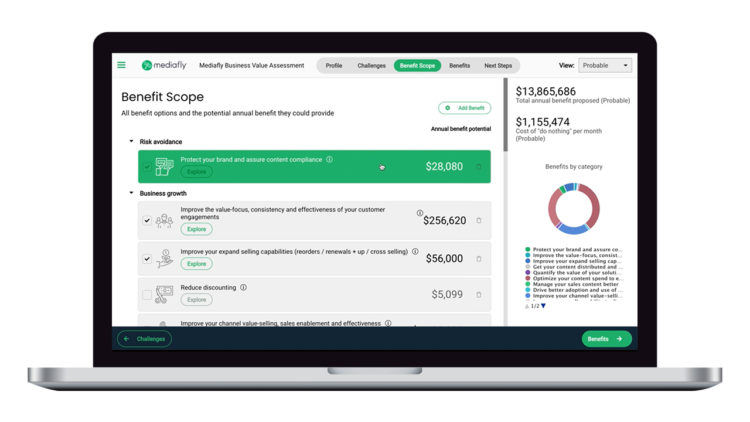
Presentation Software
When many people think of sales enablement, their minds often go to content management. But it isn’t enough to just empower your sellers with content for the meeting. You also need to enable them to present that content in the meeting. And in a world where most sales interactions are now happening digitally and remotely, that content better be good.
G2 offers a full list of the best presentation software from basic Microsoft PowerPoint or Google Slides to more advanced visual communications tools like Mediafly and Prezi here.
Web-based File Storage
Sales organizations, especially marketing departments within those organizations, rely heavily on collaboration to get their jobs done. Creating, writing, designing, and editing content for sales teams to leverage with customers isn’t easy. It’s further complicated when marketers have to download, edit and re-upload a document every time they need to suggest or make a change to a content asset.
Cloud storage providers including Box, OneDrive, and Google Drive exist to help marketers simplify workflows and collaboration. Having the ability to work parallel with one another in a document and automatically track and save changes, keeps everyone on the same page (literally!) and ensures your marketers can get the assets the sales team needs to close deals out faster.
Business Instant Messaging
The phrase “instant messaging” was popularized in the 1990s by PowWow, ICQ, and AOL Instant Messenger (AIM), but the concept actually dates back to the mid-1960s. The Compatible Time-Sharing System (CTSS) created at MIT’s Computation Center in 1961, for example, allowed up to 30 users to log in simultaneously and send messages to one another.
Today, most people have traded in embarrassing screen names (cheergirl412 – guilty) for Microsoft Teams or Slack accounts.
G2 offers a full list of the best business instant messaging software here.
Video Conferencing Software
AT&T first introduced video conferencing at the World Fair in New York in 1964. The system consisted of two closed circuit televisions systems connected by a single cable.
Today, most businesses rely on video conferencing software including Google Meet and Zoom, to continue to engage clients and colleagues face to face during the coronavirus pandemic.
See G2’s recommendations for the best video conferencing solutions here.
Project Management Tools
Polish economist Karol Adamiecki attempted to display task development in a floating chart in 1896, laying the foundation for today’s project management software. His invention, the harmonogram, incorporated the best features of the PERT and Gantt charts introduced in the 1950s, and increased productivity between 100 and 400% in a variety of industries.
Modern project management tools including Asana, Trello, and others included on G2’s best project management software list help keep teams on task by allowing you to manage all of your projects in one place.
Account-Based Marketing Tools
Coined in 2004, account-based marketing (ABM) is a fairly new term that takes personalization to a whole new level. According to Optimizely, “Account based marketing (ABM) is a business marketing strategy that concentrates resources on a set of target accounts within a market. It uses personalized campaigns designed to engage each account, basing the marketing message on the specific attributes and needs of the account.”
Leading account-based orchestration platforms include Hubspot Marketing Hub and 6sense. G2 offers a full list here.
Revenue Operations Software
In recent years, we’ve seen B2B buyers trend away from a traditional, often linear buyer journey. As a result, sales organizations can no longer take a siloed approach to sales, marketing, and customer success. The need to bring these commercial teams into one unified organization has been the catalyst for the introduction of a new function: revenue operations.
Revenue operations software such as Gong, InsightSquared, and Gainsight help deliver visibility into commercial processes so you can understand where, why and how you win.
You can view G2’s list of the best revenue operations software here.
Why Traditional Sales Enablement is Dead
Historically, most companies have built their sales enablement charters to support, you guessed it, sales reps. But today, we know the most successful sales enablement programs empower all customer-facing teams from marketing to sales to customer success. Here are a few reasons why:
- 67% of the buyer’s journey is now done digitally (SiriusDecisions)
- 68% of buyers don’t want to interact with a sales rep (Forrester)
- Only 17% of a buying group’s time is spent meeting with potential suppliers (Gartner)
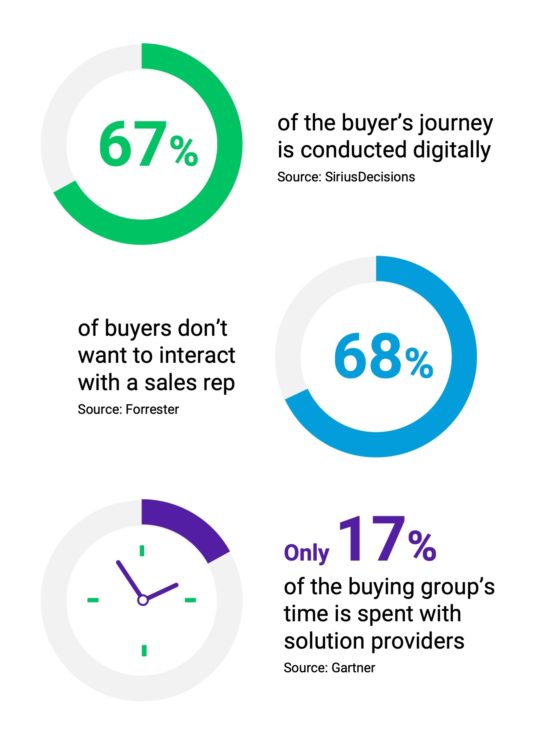
Source: Gartner
The buyer journey used to be linear. Marketing teams would generate leads, toss them over the fence to sales, and hope for the best. Technology, processes, and even goals were siloed. But in recent years, B2B buying behaviors have changed significantly.
Empowered by a vast amount of public content and information, modern buyers prefer to engage with sales reps late, or sometimes, not at all. And with 67% of the buyer journey in marketing’s hands, marketers have become increasingly accountable for revenue.
At the same time, mass adoption of subscription pricing models and increased competition have made having a dedicated team to ensure your customers remain happy and loyal a requirement.
To be successful, today’s marketing, sales, and customer success teams must work together towards the common goals of driving revenue and company growth. Creating a sales enablement program that supports and empowers each of these groups to consistently and effectively engage prospective and existing customers with the content, information, and tools they need to move deals forward and retain and grow existing accounts is essential to achieving those goals.
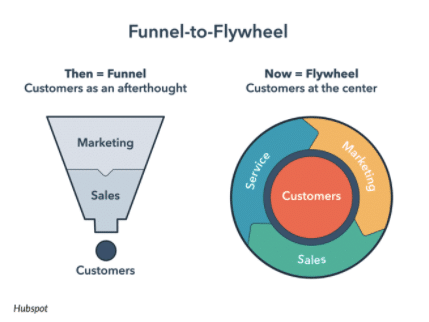
Source: Hubspot
Best Practices for a Modern Sales Enablement Program
As you build out your sales enablement program, here are some best practices to consider to maximize ROI.
- All of your commercial teams should have a seat at the table as you begin to build your sales enablement practice. More specifically, marketing and sales should share ownership of your sales enablement program. Today’s sellers have less opportunity to influence customer decisions. Meanwhile, today’s marketers have more. If your program is built to only support your sales reps, you are missing out on a huge opportunity.
- Enable all customer-facing teams, not just sales. To the same effect, all of your customer-facing teams should have access to the same resources, tools, and content to ensure customers receive a consistent and engaging buying experience.
- People + Process + Content + Technology = Sales Enablement. Don’t just invest in a sales enablement platform. Sales enablement technology is only as good as the people and processes that drive it and the content housed within it. You need all four of these components in place to be successful.
- Treat sales enablement as a journey, and invest in the resources and technology that will drive the greatest ROI for your organization first. You’re not going to launch a best-in-class sales enablement program overnight. Identify your goals and key performance indicators (KPIs) you’ll use to measure your progress towards these goals, and then work to acquire the technology that will help you move the needle on those measures.
- Don’t neglect your content. You can have the most advanced sales enablement technology in the world, but if the content you store within it is crap, you’re not going to achieve the results you want. Think strategically about both copy and format. What content do you need to educate and engage your buyer?
- Integrate. Strive to create a tech ecosystem, not a tech stack. The more seamlessly your technology works together, the more efficient and effective your teams will be and the better your customer experience will feel.
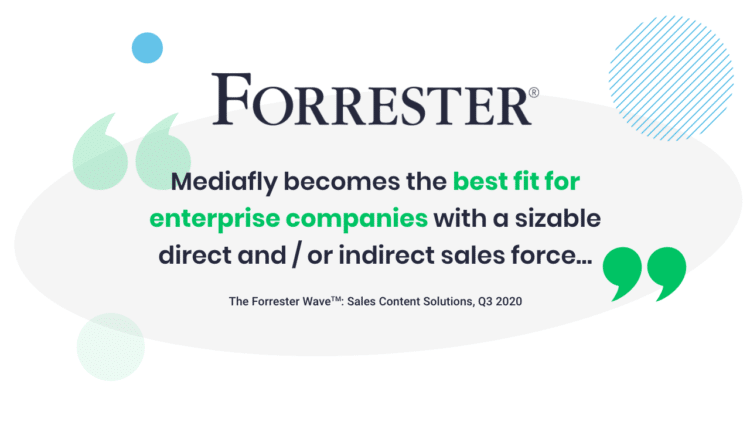
The Benefits of Sales Enablement
The global sales enablement market was worth $989 million in 2020. That number is projected to grow to $3.1 billion by 2026 – a 17.4% compound annual growth rate.
Why are businesses all over the world prioritizing sales enablement?
Today’s sales organizations find it increasingly difficult to capture buyers’ attention, help buyers justify purchase decisions, close deals, and continue to grow customer relationships post-sale.
An effective sales enablement program provides revenue teams the tools, content, knowledge, and coaching they need to efficiently and effectively engage buyers and customers and drive business growth.
Companies that leverage sales enablement, achieve impressive business outcomes including:
- 25% reduction in content waste
- 100% increase in content engagement
- 66% increase in revenue
- 43% increase in deals won
- 25% time saved for reps
Curious about the specific ROI you could see with a sales enablement solution? Find out using this interactive calculator.
Key Takeaways
- Sales enablement combines the processes, knowledge, technology and content revenue teams need to better engage prospects and customers and boost revenue
- Sales enablement is not one-size fits all and doesn’t happen overnight.
- A lot of tools and technology fall under the sales enablement umbrella. That doesn’t mean you need everything. Tailor your sales enablement journey to your business to maximize ROI.
- When evaluating sales enablement technology, G2 is a great resource to help you research and compare vendors.
- Don’t just enable your sales team. All of your customer-facing teams need access to the same content, resources, and technology.
Ready to embark on your sales enablement journey? Download our Sales Enablement Toolkit for more tips and tricks.
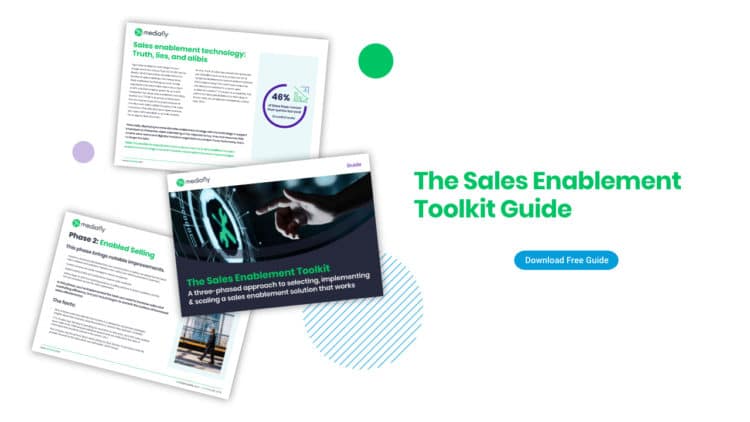

Comments are closed.